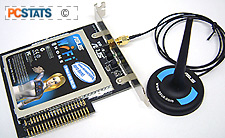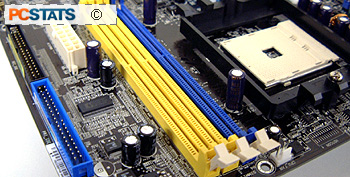A few years ago home networking really took off. If
you're house had CAT5 Ethernet cable running through the baseboards you were ahead
of the curve. Manufacturers saw a real market for people looking to have the effective connectivity
of an Ethernet network, without the cost and trouble of laying down meters of blue cable.
The
solution was to go wireless, and shortly thereafter the industry experienced a
slow and steady boom in WiFi - 802.11b networking. For consumers with three
or four PCs in one
household, wireless networking is a relatively inexpensive means to connect them all together.
While wireless signals fare best in unobstructed spaces, the signals can typically penetrate
walls and doors without too much signal loss. The main difference then becomes the transmissions rates,
where 802.11b sits at 11mbps as opposed to 10/100 wired Ethernet that runs at 100mbps.
For consumers with three
or four PCs in one
household, wireless networking is a relatively inexpensive means to connect them all together.
While wireless signals fare best in unobstructed spaces, the signals can typically penetrate
walls and doors without too much signal loss. The main difference then becomes the transmissions rates,
where 802.11b sits at 11mbps as opposed to 10/100 wired Ethernet that runs at 100mbps.
Making life easier for the consumer, Asus has
thoughtfully bundled in its own wireless 802.11b adapter card and dipole antenna with the K8V-DLXWiFiB motherboard. It's a proprietary
Wireless Fidelity slot, so the card won't work with
anything other than Asus motherboards with the appropriate connector, but it's still a
very useful feature to be bundled in. The Dipole antenna sits at the end of a
60cm cable so it can be positioned up on top of a desk for better range.
The WiFi NIC works at
the standard 802.11b frequency of 2.4~2.5 GHz, and indoors it should have a
useful distance of about 30m. If you ever take you PC outdoors (say, a LAN gaming event
in a major arena) the useful unobstructed range at 11Mbps transmission rate could be about 300 meters.
For wired communications,
the Asus K8V-DLX/WiFiB
has an onboard 3Com Marvell Gigabit NIC which works
to transmit data at upto 1000mbps. That network adapter should easily satisfy all your
high bandwidth/performance needs during a fever pitched LAN game event.
:-)
Asus Extra's You Can Count On
 Asus not only include a lot of extra hardware
with the K8V-DLX/WiFiB motherboard, they also include a ton of support features that
are built right in. First off is
Asus's CPR (CPU Parameter Recall)
function. Basically, should you overclock your system too high and get no POST,
all you have to do is turn your system off and turn it back on and your BIOS
will rest to default. During testing this feature worked flawlessly and saved us
a lot of time. Not once did CPR reset our settings when it wasn't
required.
Asus not only include a lot of extra hardware
with the K8V-DLX/WiFiB motherboard, they also include a ton of support features that
are built right in. First off is
Asus's CPR (CPU Parameter Recall)
function. Basically, should you overclock your system too high and get no POST,
all you have to do is turn your system off and turn it back on and your BIOS
will rest to default. During testing this feature worked flawlessly and saved us
a lot of time. Not once did CPR reset our settings when it wasn't
required.
Asus Ai BIOS actually incorporates three
different features, the first is Asus Q-Fan Technology. Q-Fan adjusts the CPU fan speed according to how much load
the system is under and by how
hot the processor is running. In today's world of high speed, high heat, high noise CPU
coolers; Q-Fan can make a system noticeably quieter.
While in
theory this is a great application, Q-Fan didn't work out very well. It
seemed to sped up and slow down the CPU fan so much that we could often hear two
tones from the main HSF which was rather annoying. The Asus POST
reporter will speak to you via the system speaker or speakers connected
to the PC when POSTs. If something is wrong you'll hear about it instead of
having to try and figure things out on your own. Lastly Asus' CrashFree
BIOS 2 is a
BIOS savior which restores the original BIOS data fro the Asus support CD when the
BIOS has been corrupted. This is always handy!
